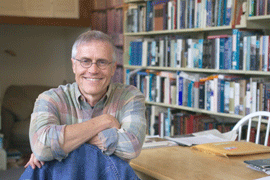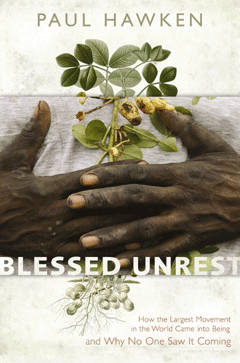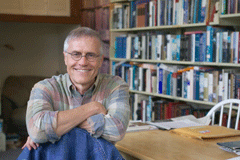Blessedly Unrestful
Air Date: Week of June 15, 2007

(Courtesy of Viking Press)
Author, activist and businessman Paul Hawken talks to Living on Earth's Steve Curwood about his new book, "Blessed Unrest." In the book, Hawken looks at how the social justice and environmental movements developed over the past two hundred years and how they have changed the way that governments and businesses act toward people and the Earth.
Transcript
CURWOOD: In his 40 years as a businessman, writer and environmental innovator, Paul Hawken has worked and spoken with hundreds of small, nonprofit organizations. These are groups that work on everything from sustainable business practices to urban planning, to rainforest protection to prison reform. They span a remarkable and growing spectrum of causes and concerns and after a while, it became apparent to Paul Hawken that these groups are actually all part of one global, decentralized movement. He says it is arising in response to the downsides of industrialization and globalization. After ten years of research on these groups and the growing links among them, Paul Hawken has written a book entitled “Blessed Unrest: How the Largest Movement in the World Came into Being and Why No One Saw It Coming.” He says it’s drawing together groups focused on such broad, but often separate themes as the environment, social justice and the rights of indigenous peoples.
HAWKEN: They are seen as separate in many ways. Their activities are very specific but in fact they are realizing, as I think many of us are, that in order to be effective in the areas in which they concentrate, they have to work as a system. They have to collaborate and they have to communicate with each other.
CURWOOD: So, how is this different from say previous social movements, like abolition or suffrage, or the environmental movement?

Hawken's newest book, "Blessed Unrest"
(Courtesy of Viking Press)
HAWKEN: Most movements, first of all, are created because there’s an imbalance of power and it tries to aggregate that power to itself. And this movement is trying to disperse the pathological concentrations of power because it sees that as one of the main causes of the things it’s addressing. Second of all, movements usually arise because there’s a charismatic leader. And that leader then gathers people around him or her and then a movement grows and morphs outwards. But this movement is truly a bottom up movement. And the third reason it’s different, is because it doesn’t really know it’s a movement. That is to say it didn’t organize itself originally to be a concentration of power. It has no centrality. And what you’re seeing now due to modern-day technologies—the internet, texting, cell phones—is that this huge, at one-time inchoate, movement is starting to hook-up and collaborate and become more powerful.
CURWOOD: Now, poverty has a huge impact on the health of the environment. And yet many of the best-funded environmental groups tend to think first of habitat preservation and maybe second of reducing poverty. You argue that the separation between human rights and the environmental movement is really a false split. Can you explain that please?
HAWKEN: I will in several ways. First of all, we include indigenous movements, and I think they’re critical in two ways. One because they are the custodians and stewards of the last great remaining stands of timber and minerals, and water, and the earth. They are being now sort of confronted by corporate interests all over the world and so their guardianship is critical to the survival of this planet. Second, because indigenous groups never disaggregated the concept of social justice and the environment. It’s a concept that doesn’t even occur to them that injustice to one is injustice to the other. I think the way I see it is that we in the West definitely have seen them as separate. But from my point of view the fact is that we have a political economic system that’s stealing from the future and selling then it in the present as GDP or as a profit. And whether you steal that in the form of a clear-cut forest in British Columbia, or whether you steal it in the form of exploitation of child workers, or whether it’s a toxic factory in China, you’re doing exactly the same thing. That is to say you’re foreclosing the future for people by destroying either a place or people themselves.
CURWOOD: Now, you’re a businessman. I believe you started in Boston with an organic grocery store and Smith and Hawken’s, a well-known garden tool company. And it sounds like you think business is the problem here.

Author Paul Hawken (Courtesy of Paul Hawken)
HAWKEN: Business has always been the problem. It’s been the problem since the conquest and it’s gotten worse and worse, and worse. And at the same time there are many, many businesses who are organizing themselves to address these problems. This is not solvable without business and government. I do not mean to imply, by focusing on civil society, that somehow it’s going to save the day. Really, what I’m saying here, this is not a movement that’s trying to aggregate power. This is a movement that’s trying to suffuse the institutions of the world with new ways of thinking, new ways of doing things, new ways of being. So therefore its effectiveness, and in the end looking back, its power if you will, will be measured by how much it changes other institutions, and business is certainly one of those important institutions.
CURWOOD: At one point in your book, Paul, you argue that globalization of commerce and trade is pushing communities around the world into a homogenous culture of consumption. There’s a Nike sneaker on every foot. There’s a can of Coca-Cola in every hand. How is this movement you describe responding to this spread of commodity culture?
HAWKEN: I think one of the great responses to it is you’re seeing it in localization of economies. You’re seeing it in the slow food movement, which is very much about farming and culture. And you’re seeing it as an expression and a need for people to create resilience in their own communities. You know this post-carbon movement. This idea that a locale should be more interdependent with respect to fuel, energy, food, transportation. And in the process, it is rediscovering its own cultural, biological, culinary roots. And you’re starting to see people reassemble things that they have lost. And this is true all over the world. Globalization has created this sense of loss that went so far and has gone so far that I think you’re starting to see it come back. And it’s being driven very, very much by the threats that peak oil pose. But there’s not just peak oil, there’s peak soil, there’s peak water. There’s a lot of peaks coming and they’re all related. And so people are starting to you know to sniff the wind, feel it and starting to create again, alternatives to this in their communities.
CURWOOD: Paul Hawken, you’re not afraid of big ideas and you advance one in this book based on the Gaia hypothesis, that is that the earth is really one living organism. And you say just like living organisms have an immune system, this social reaction to what’s happening with to the environmental degradation of the planet is being responded to by us as a body would respond to an infection.
HAWKEN: Well, many scientists and philosophers have speculated for centuries that humanity itself acts like an organism. No one’s been able to prove this or disprove it. It’s just simply something that observationally seems to be evident and true. I am building on that and saying what I believe is the only reasonable explanation to describe and justify what you see arising, since it doesn’t have a source as some other agent. So I turn to biological metaphors and I turn to the immune system because the immune system is the most complex system in the body by far. Our idea of the immune system is that it’s like the department of defense and it kills invaders, and it certainly can do that. But long before it does that, it’s like a big chamber of commerce mixer, where everybody is meeting eachother, including pathogens. And it tries détente and rapprochement before it tries death. So if we understand that there is within us individually this ability, why not as community? We are a community of cells. There is no such thing as a single cell in the sense of how it acts. It acts in community. We act in community. And because of communication, because of globalization, because of technology there’s no reason that we can’t imagine that we in some collective way are now acting as communities and evincing characteristics and responses that make total sense from a biological point of view, which is that we want to persist. We want to create a durable living economy. We want to restore some semblance of grace and justice, and beauty to our lives and those that follow us. And I feel that this movement is that expression. This movement, that may never have a name but is growing more powerfully and more quickly than anything else on earth.
CURWOOD: Paul Hawken’s latest book is called “Blessed Unrest: How the Largest Movement in the World Came into Being and Why No One Saw it Coming.” Thank, you Paul.
HAWKEN: Thank you, Steve.
[MUSIC: Max Richter “Organum” from ‘The Blue Notebooks’ (Fat Cat Records – 2004)]
CURWOOD: And you can hear more of our interview with Paul Hawken on our Web site, LOE.org.
[MUSIC UP AND UNDER]
Links
Hawken's website, Wiser Earth connects social activist networks around the world
Living on Earth wants to hear from you!
Living on Earth
62 Calef Highway, Suite 212
Lee, NH 03861
Telephone: 617-287-4121
E-mail: comments@loe.org
Newsletter [Click here]
Donate to Living on Earth!
Living on Earth is an independent media program and relies entirely on contributions from listeners and institutions supporting public service. Please donate now to preserve an independent environmental voice.
NewsletterLiving on Earth offers a weekly delivery of the show's rundown to your mailbox. Sign up for our newsletter today!
 Sailors For The Sea: Be the change you want to sea.
Sailors For The Sea: Be the change you want to sea.
 The Grantham Foundation for the Protection of the Environment: Committed to protecting and improving the health of the global environment.
The Grantham Foundation for the Protection of the Environment: Committed to protecting and improving the health of the global environment.
 Contribute to Living on Earth and receive, as our gift to you, an archival print of one of Mark Seth Lender's extraordinary wildlife photographs. Follow the link to see Mark's current collection of photographs.
Contribute to Living on Earth and receive, as our gift to you, an archival print of one of Mark Seth Lender's extraordinary wildlife photographs. Follow the link to see Mark's current collection of photographs.
 Buy a signed copy of Mark Seth Lender's book Smeagull the Seagull & support Living on Earth
Buy a signed copy of Mark Seth Lender's book Smeagull the Seagull & support Living on Earth

